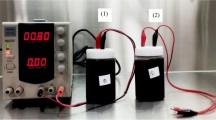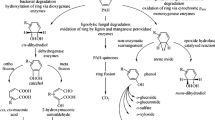Abstract
Purpose
The major aromatic constituents of petroleum products viz. benzene, toluene, and mixture of xylenes (BTX) are responsible for environmental pollution and inflict serious public concern. Therefore, BTX biodegradation potential of individual as well as formulated bacterial consortium was evaluated. This study highlighted the role of hydrogen peroxide (H2O2), nitrate, and phosphate in stimulating the biodegradation of BTX compounds under hypoxic condition.
Materials and methods
The individual bacterium viz. Bacillus subtilis DM-04 and Pseudomonas aeruginosa M and NM strains and a consortium comprising of the above bacteria were inoculated to BTX-containing liquid medium and in soil. The bioremediation experiment was carried out for 120 h in BTX-containing liquid culture and for 90 days in BTX-contaminated soil. The kinetics of BTX degradation either in presence or absence of H2O2, nitrate, and phosphate was analyzed using biochemical and gas chromatographic (GC) technique.
Results
Bacterial consortium was found to be superior in degrading BTX either in soil or in liquid medium as compared to degradation of same compounds by individual strains of the consortium. The rate of BTX biodegradation was further enhanced when the liquid medium/soil was exogenously supplemented with 0.01 % (v/v) H2O2, phosphate, and nitrate. The GC analysis of BTX biodegradation (90 days post-inoculation) in soil by bacterial consortium confirmed the preferential degradation of benzene compared to m-xylene and toluene.
Conclusions
It may be concluded that the bacterial consortium in the present study can degrade BTX compounds at a significantly higher rate as compared to the degradation of the same compounds by individual members of the consortium. Further, addition of H2O2 in the culture medium as an additional source of oxygen, and nitrate and phosphate as an alternative electron acceptor and macronutrient, respectively, significantly enhanced the rate of BTX biodegradation under oxygen-limited condition.

Similar content being viewed by others
References
Agency for Toxic Substances and Disease Registry (ASTDR), 2000. CAS #: 108-88-3. Available online at: http://www.atsdr.cdc.gov/es
Agency for Toxic Substances and Disease Registry (ASTDR), 2005a. CAS #: 71-43-2. Available online at: http://www.atsdr.cdc.gov/es
Agency for Toxic Substances and Disease Registry (ASTDR), 2005b. CAS #: 1330-20-7. Available online at: http://www.atsdr.cdc.gov/es
Anid PJ, Alvarez PJJ, Vogel TM (1993) Biodegradation of monoaromatic hydrocarbons in aquifer columns amended with hydrogen peroxide and nitrate. Water Res 27:685–691
Attway HH, Schmidt MG (2002) Tendam biodegradation of BTEX components by two Pseudomonas sp. Curr Microbiol 45:30–36
Daniel WW (2000) Biostatistics: A foundation for analysis in the health sciences, 7th edn. Wiley, New York, pp 166–167
Das K, Mukherjee AK (2005) Characterization of biochemical properties and biological activities of biosurfactants produced by Pseudomonas aeruginosa mucoid and non-mucoid strains. J Appl Microbiol Biotechnol 69:192–195
Das K, Mukherjee AK (2007a) Crude petroleum-oil biodegradation efficiency of Bacillus subtilis and Pseudomonas aeruginosa strains isolated from petroleum oil contaminated soil from North-East India. Biores Technol 98:1339–1345
Das K, Mukherjee AK (2007b) Comparison of lipopeptide biosurfactants production by Bacillus subtilis strains in submerged and solid state fermentation systems using a cheap carbon source: some industrial applications of biosurfactants. Process Biochem 42:1191–1199
Das K, Mukherjee AK (2007c) Differential utilization of pyrene as the sole source of carbon by Bacillus subtilis and Pseudomonas aeruginosa strains: role of biosurfactants in enhancing bioavailability. J Appl Microbiol 102:195–203
Farhadian M, Vachelard C, Duchez D, Larroche C (2008) In situ bioremediation of monoaromatic pollutants in groundwater: a review. Biores Technol 99:5296–5308
Farhadian M, Duchez D, Vachelard C, Larroche C (2009) Accurate quantitative determination of monoaromatic compounds for the monitoring of bioremediation processes. Biores Technol 100:173–178
Fiorenza S, Ward CH (1997) Microbial adaptation to hydrogen peroxide and biodegradation of aromatic hydrocarbons. J Ind Microbiol Biotechnol 18:140–151
Goudar C, Quinlan C, Strevett K (2000) Biodegradation kinetics of BTEX in a compost biofilter. 219th American Chemical Society Meeting, BIOT-048, San Francisco, CA. March 26–30
Hamed T A, Bayraktar E, Mehmetog˘lu T, Mehmetog˘lu U¨ lku (2003) Substrate interactions during the biodegradation of benzene, toluene and phenol mixtures. Process Biochem 39: 27-35
Jean JS, Tsai CL, Ju SH, Tsao CW, Wang SM (2002) Biodegradation and transport of benzene, toluene, and xylenes in a simulated aquifer: comparison of modelled and experimental results. Hydrol Process 16:3151–3168
Jean JS, Wang Lee MK, Chattopadhyay SM, Maity JP (2008) Effects of inorganic nutrient levels on the biodegradation of benzene, toluene, and xylene (BTX) by Pseudomonas spp. in a laboratory porous media sand aquifer model. Biores Technol 99:7807–7815
Jo MS, Rene ER, Kim SH, Park HS (2008) Removal of BTEX compounds by industrial sludge microbes in batch system: statistical analysis of main and interaction effects. World J Microbiol Biotechnol 24:73–78
Johnson SJ, Woolhouse KJ, Prommer H, Barry DA, Christofi N (2003) Contribution of anaerobic microbial activity to natural attenuation of benzene in groundwater. Eng Geol 70:343–349
Leahy JG, Tracy KD, Eley MH (2003) Degradation of mixtures of aromatic and chloroaliphatic hydrocarbons by aromatic hydrocarbon degrading bacteria. FEMS Microbiol Ecol 1458:1–6
Lee MD, Thomas JM, Borden RC, Bedient PB, Ward CH, Wilson JT (1988) Biorestoration of aquifers contaminated with organic compounds. CRC Crit Rev Environ Control 18:29–89
Liu JH, Maity JP, Jean JS, Chen CY, Chen CC, Ho SY (2010) Biodegradation of benzene by pure and mixed cultures of Bacillus spp. World J Microbiol Biotechnol 26:1557–1567
Lowry OH, Rosebrough NJ, Farr AL, Randall RJ (1951) Protein measurement with the folin phenol reagent. J Biol Chem 193:265–275
Lu C, Chu W, Lin MR (2000) Removal of BTEX vapor from waste gases by a trickle bed biofilter. J Air Waste Manag Assoc 50:411–417
Makkar RS, Cameotra SS (1998) Production of biosurfactant at mesophilic and thermophilic conditions by a strain of Bacillus subtis. J Ind Microbiol Biotechnol 20:48–52
Mason CA, Ward G, Abu-Salah K, Karen O, Dosoretz CG (2000) Biodegradation of BTEX by bacteria on powdered activated carbon. Bioprocess Eng 23:331–336
Morgan P, Lewis ST, Watkinson RJ (1993) Biodegradation of benzene, toluene, ethylbenzene and xylenes in gas condensate-contaminated groundwater. Environ Pollut 82:181–190
Mukherjee AK, Bordoloi NK (2011) Bioremediation and reclamation of soil contaminated with petroleum oil hydrocarbons by exogenously seeded bacterial consortium: a pilot-scale study. Environ Sci Pollut Res 18:471–478
Mukherjee AK, Das K (2005) Correlation between diverse cyclic lipopeptides production and regulation of growth and substrate utilization by Bacillus subtilis strains in a particular habitat. FEMS Microbiol Ecol 54:479–489
Paixão JF, Nascimento IA, Pereira SA, Leite MBL, Carvalho GC, Silveira JSC Jr, Rebouças M, Matias GRA, Rodrigues ILP (2007) Estimating the gasoline components and formulations toxicity to microalgae (Tetraselmis chuii) and oyster (Crassostrea rhizophorae) embryos: an approach to minimize environmental pollution risk. Environ Res 103:365–374
Phelps CD, Young LY (1999) Anaerobic biodegradation of BTEX and gasoline in various aquatic sediments. Biodegradation 10:15–25
Shim H, Shin EB, Yang ST (2002) A continuous fibrous-bed bioreactor for BTEX biodegradation by a co-culture of Pseudomonas putida and Pseudomonas fluorescens. Adv Environ Res 7:203–216
Shim H, Hwang B, Lee SS, Kong SH (2005) Kinetics of BTEX biodegradation by a coculture of Pseudomonas putida and Pseudomonas fluorescens under hypoxic conditions. Biodegradation 16:319–327
Takahata Y, Kasai Y, Hoaki T, Watanabe K (2006) Rapid intrinsic biodegradation of benzene, toluene, and xylenes at the boundary of a gasoline-contaminated plume under natural attenuation. Appl Microbiol Biotechnol 73:713–722
Thomas JM, Ward CH (1989) In situ bioremediation of organic contaminants in the subsurface. Environ Sci Technol 23:760–764
Vezquez S, Nogales B, Ruberto L, Hernandez E, Christic-Oleza J, Lobalbo A, Bosch R, Lalucat J, Mac Cormack W (2009) Bacterial community dynamics during bioremediation of diesel oil-contaminated Antarctic soil. Microb Ecol 57:598–610
Wang L, Qiao N, San F, Shao Z (2008) Isolation, gene detection and solvent tolerance of benzene, toluene and xylene degrading bacteria from near shore surface water and Pacific Ocean sediment. Extremophiles 12:335–342
Wolicka D, Suszek A, Borkowski A, Bielecka A (2009) Application of aerobic microorganisms in bioremediation in situ of soil contaminated by petroleum products. Biores Technol 100:3221–3227
Yerushalmi L, Manuel MF, Guiot SR (1999) Biodegradation of gasoline and BTEX in a microaerophilic biobarrier. Biodegradation 10:341–352
Yu H, Kim BJ, Rittmann BE (2001) The roles of intermediates in biodegradation of benzene, toluene, and p-xylene by Pseudomonas putida F1. Biodegradation 12:455–463
Acknowledgments
Authors thank Dr. G. Maitra, DBT Nodal Cell, Tezpur University for editing the manuscript. Dr. N.K.B was recipient of the Institutional Research Associateship. This work was partially supported by grants received from UGC-SAP (DRS-I) and DBT, New Delhi sponsored special project—“Strengthening of Biotechnology Teaching, Training and Research in Universities and Colleges of North-East India” to A.K.M.
Author information
Authors and Affiliations
Corresponding author
Additional information
Responsible editor: Philippe Garrigues
Electronic supplementary material
Below is the link to the electronic supplementary material.
ESM 1
(DOC 36 kb)
Rights and permissions
About this article
Cite this article
Mukherjee, A.K., Bordoloi, N.K. Biodegradation of benzene, toluene, and xylene (BTX) in liquid culture and in soil by Bacillus subtilis and Pseudomonas aeruginosa strains and a formulated bacterial consortium. Environ Sci Pollut Res 19, 3380–3388 (2012). https://doi.org/10.1007/s11356-012-0862-8
Received:
Accepted:
Published:
Issue Date:
DOI: https://doi.org/10.1007/s11356-012-0862-8




